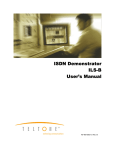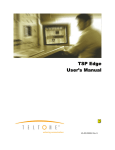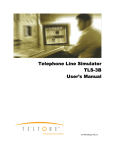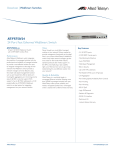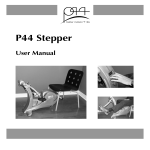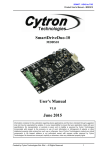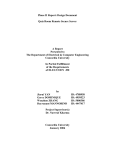Download TLS-3A Manual
Transcript
User Manual TLS-3A Telephone Line Simulator 40-400-00010, Rev. B Covers Model TLS-3A-01 Teltone Corporation 22121-20th Avenue SE Bothell, Washington 98021-4408 USA Phone: 1-800-426-3926 or 425-487-1515 Fax: 425-487-2288 E-mail: [email protected] Website: www.teltone.com This page intentionally left blank. Contents Introduction .......................................................................... 3 1. Connectors and Lights ..................................................... 4 2. How to Install the TLS-3A ................................................ 5 3. How to Operate the TLS-3A ............................................. 6 4. Specifications ................................................................... 8 5. Warranty and Service ....................................................... 9 TLS-3A-01 Telephone Line Simulator 1 Regulatory Compliance: This equipment has been tested and found to comply with the limits for a Class A digital device, pursuant to part 15 of the FCC Rules. These limits are designed to provide reasonable protection against harmful interference when the equipment is operated in a commercial environment. This equipment generates, uses and can radiate radio frequency energy and, if not installed and used in accordance with the instruction manual, may cause harmful interference in which case the user will be required to correct the interference at his own expense. Copyright © 1995 Teltone Corporation. Teltone is a registered trademark of Teltone Corporation. Teltone Corporation 22121-20th Avenue SE Bothell, WA 98021-4408 Phone: 425-487-1515 Fax: 425-487-2288 2 40-400-00010, Rev. B TLS-3A Introduction The Teltone TLS-3A is a portable, two-line device that emulates the public telephone network. The TLS-3A is a tool for demonstrating telephone instruments and other telecommunications equipment such as fax machines and modems. The TLS-3A’s small size and light weight make it ideal for trade shows and other sales presentations, and for testing telephone sets, key systems, and PBX installations. Like the public telephone network but on a smaller scale, the TLS-3A can provide dial tone, audible ring and busy signals to the telephone or other device connected to it. When a caller uses one phone or other device to dial up the second phone, the TLS-3A sends ringing current to the second phone until it goes off-hook. The TLS-3A then establishes a connection between the two phones. Either telephone can be used to call the other line. In other words, the TLS-3A is a simple telephone network in a box. When a telephone connection is not available, or when installing a temporary telephone line would be costly, the TLS-3A provides all the signals and functions you will need to demonstrate or test your telephones, modems, and other telecommunications equipment. TLS-3A-01 Telephone Line Simulator 3 1. Connectors and Lights The front panel of the TLS-3A has two telephone line jacks, with a green status indicator light for each line, and a green Power indicator light. The power input connector is on the rear panel. Status Lights When a telephone (or other device) connected to one of the Line connectors is off-hook, the corresponding Line indicator lights. The Line light dims (not totally dark) when the TLS-3A decodes valid DTMF from the off-hook device. If the off-hook device sends rotary dialing signals, the line indicator will flicker on and off during dialing. When the TLS-3A sends a ringing signal to a telephone attached to one of the Line connectors, the corresponding Line indicator flickers on and off rapidly. The green Power indicator alternates between full and half brightness when the TLS-3A is operating. If the Power indicator is dark, no power is connected to the TLS-3A. If it lights, but does not flicker, the TLS-3A’s internal processor is not working properly. Line Jacks Two Line connectors (RJ-11 modular telephone jacks) are located on the front panel. These connectors mate with the plugs on standard modular telephone cords. Power Connector The power connector requires a 24-volt DC power source. A 120 VAC 24-volt DC power pack is supplied with the TLS-3A. Do not use the TLS-3A with a power pack that supplies a different voltage. Figure 1 TLS-3A Front and Rear Panels 4 40-400-00010, Rev. B 2. How to Install the TLS-3A The TLS-3A works with analog loop start telephone sets only. It will not work with ground start, proprietary, or digital phone sets. Follow these steps to install the TLS-3A: 1. Plug the connector at the end of the power pack cable into the connector on the rear panel of the TLS-3A. 2. Plug the power pack into a 120-volt AC wall outlet. The POWER indicator will light. 3. Use a modular telephone cable to connect the telephones (or other devices such as modems or fax machines) to the LINE 1 and LINE 2 connectors of the TLS-3A. 4. Lift the handset of the telephone connected to Line 1. The LINE 1 indicator should light. Hang up and do the same thing for Line 2. Figure 2 shows a typical installation. WARNING: Do not try to connect the TLS-3A to the public telephone network. Incoming ringing signals use voltages that can damage internal components in the TLS-3A. WARNING: The TLS-3A generates a 100-volt ringing signal. Keep your hands away from the plugs at the end of modular cables plugged into the TLS-3A when the other line is off hook. Figure 2 Typical TLS-3A Installation TLS-3A-01 Telephone Line Simulator 5 3. How to Operate the TLS-3A The TLS-3A has one talk path between the two lines. When a telephone connected to either line goes off-hook while the other is still on-hook, the off-hook telephone receives dial tone. If the other telephone is already off-hook, the second telephone off-hook will not receive dial tone (silence). Each line has been assigned several telephone numbers. To call the other telephone, lift the handset and dial one of the numbers assigned to the telephone you want to call. The TLS-3A recognizes both rotary (pulse) and touchtone dialing. To call Line 2: Dial 102 or 29* One long ring (Line 2 rings two seconds on, four seconds off) Dial 202 Two short rings (Line 2 rings 0.8 seconds on, 0.4 seconds off, 0.8 sec- onds on, 0.4 seconds off) Dial any seven-digit number** Dial any eleven-digit number starting with 1 or 0 One long ring (Line 2 rings two seconds on, four seconds off) One long ring (Line 1 rings two seconds on, four seconds off) To call Line 1: Dial 101 or 40* One long ring (Line 1 rings two seconds on, four seconds off) Dial 201 Two short rings (Line 1 rings 0.8 seconds on, 0.4 seconds off, 0.8 seconds on, 0.4 seconds off) Dial any seven-digit number** One long ring (Line 1 rings two seconds on, four seconds off) *The dialing strings 29 and 40 have been included to maintain compatibility with previous TLS-3 models. **Any seven-digit number not starting with digits 0, 1, 29, 40, 101, 102, 201, 202, 83781, 83782, 83783, 83784, or 83785. 6 40-400-00010, Rev. B Dial any eleven-digit number starting with 1 or 0 One long ring (Line 1 rings two seconds on, four seconds off) When the other telephone rings, lift the handset to answer. The two telephones are now connected. To break the connection, hang up either telephone. A dialing error occurs when less than 7 digits are dialed or if the first digit is a 1 or 0 and less than 11 digits are dialed. The TLS-3A will issue a reorder tone (aka Fast Busy) approximately 8 seconds after the last DTMF digit is entered if a dialing error occurs. Forced Disconnect Either party can break a connection by hanging up the telephone (going “on-hook”). The TLS-3A will provide dial tone to the telephone still off-hook. If the called party goes back off-hook within two seconds, but the calling party remains off-hook, the TLS-3A will reestablish the connection. After the called party is on-hook for two seconds, the TLS3A will issue a COD (cut-off on disconnect) signal to the calling party. Calling Party Supervision The U.S. telephone network typically uses Calling Party Supervision, meaning that even though the called party hangs up, he may be reconnected to the calling party when the phone is taken off-hook again. The calling party must hang up for the called party to be fully disconnected before initiating a new call. The telephone network will timeout and disconnect the call within 5-20 seconds, giving the called party dial tone when he goes off-hook again. The TLS-3A will issue a COD signal to the called party two seconds after the calling party goes on-hook for a valid on-hook time of 350 milliseconds. If the calling party goes off-hook again, the caller will hear silence until all other actions are complete. Ring Down Operation In addition to using the dialed numbers, it’s also possible to send a continuous ringing signal from one telephone to the other. Follow these steps to send a ring down signal: 1. Lift the handset on the telephone set from which you want to originate the call. 2. Press the hold down the button. The other telephone will ring as long as you button. Demonstrating and Testing Equipment To demonstrate or test telephone equipment, connect the instruments to Line 1 and Line 2. The equipment will work through the TLS-3A exactly the same way it works through the public telephone network. TLS-3A-01 Telephone Line Simulator 7 Use one of the two- or three-digit telephone numbers assigned to the line you want to call, or use any seven-digit telephone number. Like the public telephone network, the TLS-3A will not accept a seven-digit number with a 1 or 0 as the first digit. Such a number produces a reorder tone. Dial Up Test Numbers The TLS-3A-01 supports 5 dial up test numbers. These include: TEST1 dialed as 83781, the caller will hear a continuous Dial tone. TEST2 dialed at 83782, the caller will hear a continuous Busy tone. TEST3 dialed as 83783, the caller will hear a continuous Fast Busy tone (aka Reorder tone). TEST4 dialed as 83784, the caller will hear a continuous Ringback tone (aka audible ringing). TEST5 dialed as 83785, the caller will hear continuous silence. All dial up test numbers will continue to issue their particular tone sequence until the caller goes back on-hook. 8 40-400-00010, Rev. B 4. Specifications Physical Dimensions Weight 5.5" x 1.5" x 9.0" 1 lb, 5 oz Environmental Operating temperature Storage temperature 0° to +50° C @ 95% humidity, non-condensing -20° to +60° C long term Electrical Power input On hook voltage Ringing Voltage 24 VDC nominal, 500 mA minimum -42 VDC nominal ≥ 50 VAC RMS @20 Hz, @3 REN Signaling Ring frequency Ring waveform Dial tone delay Network response delay Line attenuation 20 Hz Rounded Square Wave 0.1 seconds 0.2 seconds 6 dB Call progress signals Dial tone Ringback Busy Reorder 350 + 440 Hz continuous 440 + 480 Hz follows ringing cadence 480 + 620 Hz 500 ms on/500 ms off 480 + 620 Hz 250 ms on/250 ms off Tone input level Forced disconnect duration Line impedance Dialing requirements Rotary DTMF tone on/off Talk path attenuation On/off-hook detect Off-hook loop current tance On-hook detect -19 dBm +/- 3 dB 850 ms +/- 25 ms 900 ohms 8 - 12 pps >40 ms 6 dB (nominal) <6 mA = on-hook >18 mA = off-hook >25 mA with 400 ohms total loop resis>400 ms TLS-3A-01 Telephone Line Simulator 9 5. Warranty and Service Warranty Information Teltone warrants this product to be free from defects in material and workmanship for a period of two years, given proper installation and usage. At its sole discretion, Teltone will repair or replace free of charge any unit found to be defective during the warranty period. Units found defective beyond the warranty period will be repaired or replaced at a flat rate. Return Procedures If a unit is found to be defective, contact Teltone Repair Order Entry at 1-800-426-3926 or 425-487-1515 to obtain a Material Return Authorization (MRA) number. When returning units, provide the following information: Unit model number, unit part number, and serial number • Teltone MRA number • All fault information available • Complete shipping and billing address • Repair purchase order When returning a unit, ship it to: Teltone Corporation ATTN: (write MRA number here) 22121-20th Avenue SE Bothell, WA 98021-4408 Technical Assistance For technical assistance on this product, call Teltone Corporation at 1-800-426-3926 or 425-487-1515 and ask for TLS Technical Support. 10 40-400-00010, Rev. B













